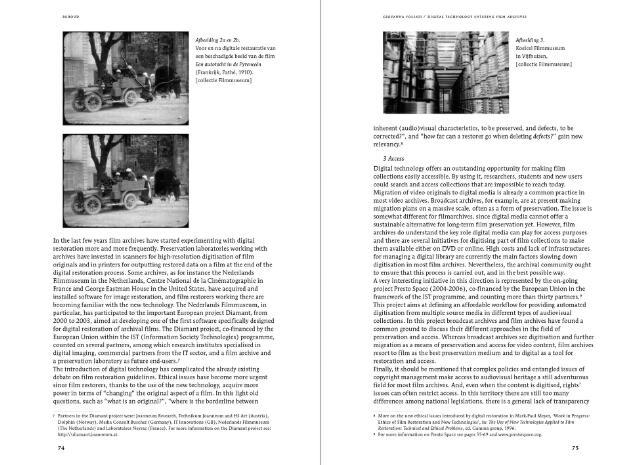In the last few years film archives have started experimenting with digital
restoration more and more frequently. Preservation laboratories working with
archives have invested in scanners for high-resolution digitisation of film
originals and in printers for outputting restored data on a film at the end of the
digital restoration process. Some archives, as for instance the Nederlands
Filmmuseum in the Netherlands, Centre National de la Cinématographie in
France and George Eastman House in the United States, have acquired and
installed software for image restoration, and film restorers working there are
becoming familiar with the new technology. The Nederlands Filmmuseum, in
particular, has participated to the important European project Diamant, from
2000 to 2003, aimed at developing one of the first software specifically designed
for digital restoration of archival films. The Diamant project, co-financed by the
European Union within the 1ST (Information Society Technologies) programme,
counted on several partners, among which research institutes specialised in
digital imaging, commercial partners from the IT sector, and a film archive and
a preservation laboratory as future end-users.7
The introduction of digital technology has complicated the already existing
debate on film restoration guidelines. Ethical issues have become more urgent
since film restorers, thanks to the use of the new technology, acquire more
power in terms of "changing" the original aspect of a film. In this light old
questions, such as "what is an original?", "where is the borderline between
inherent (audio)visual characteristics, to be preserved, and defects, to be
corrected?", and "how far can a restorer go when deleting defectsgain new
relevancy.8
3 Access
Digital technology offers an outstanding opportunity for making film
collections easily accessible. By using it, researchers, students and new users
could search and access collections that are impossible to reach today.
Migration of video originals to digital media is already a common practice in
most video archives. Broadcast archives, for example, are at present making
migration plans on a massive scale, often as a form of preservation. The issue is
somewhat different for filmarchives, since digital media cannot offer a
sustainable alternative for long-term film preservation yet. However, film
archives do understand the key role digital media can play for access purposes
and there are several initiatives for digitising part of film collections to make
them available either on DVD or online. High costs and lack of infrastructures
for managing a digital library are currently the main factors slowing down
digitisation in most film archives. Nevertheless, the archival community ought
to ensure that this process is carried out, and in the best possible way.
A very interesting initiative in this direction is represented by the on-going
project Presto Space (2004-2006), co-financed by the European Union in the
framework of the 1ST programme, and counting more than thirty partners.9
This project aims at defining an affordable workflow for providing automated
digitisation from multiple source media in different types of audiovisual
collections. In this project broadcast archives and film archives have found a
common ground to discuss their different approaches in the field of
preservation and access. Whereas broadcast archives see digitisation and further
migration as a means of preservation and access for video content, film archives
resort to film as the best preservation medium and to digital as a tool for
restoration and access.
Finally, it should be mentioned that complex policies and entangled issues of
copyright management make access to audiovisual heritage a still adventurous
field for most film archives. And, even when the content is digitised, rights'
issues can often restrict access. In this territory there are still too many
differences among national legislations, there is a general lack of transparency
BEHOUD
Afbeelding 2a en 2b.
Voor en na digitale restauratie van
een beschadigde beeld van de film
Een autotocht in de Pyreneeën
(Frankrijk, Pathé, 1910).
[collectie Filmmuseum]
7 Partners in the Diamant project were: Joanneum Research, Technikum Joanneum and HS Art (Austria),
Dolphin (Norway), Media Consult Buscher (Germany), IT Innovations (GB), Nederlands Filmmuseum
(The Netherlands) and Laboratoires Neyrac (France). For more information on the Diamant project see:
http:Wdiamant.joanneum.at.
74
GIOVANNA FOSSATI DIGITAL TECHNOLOGY ENTERING FILM ARCHIVES
Afbeelding 3.
Koelcel Filmmuseum
in Vijfhuizen,
[collectie Filmmuseum]
8 More on the new ethical issues introduced by digital restoration in Mark-Paul Meyer, 'Work in Progress:
Ethics of Film Restoration and New Technologies', in: The Use of New Technologies Applied to Film
Restoration: Technical and Ethical Problems, ed. Gamma group, 1996.
9 For more information on Presto Space see pages 55-69 and www.prestospace.org.
75

